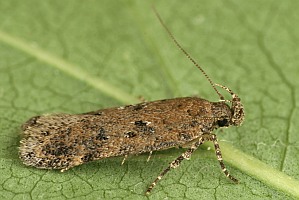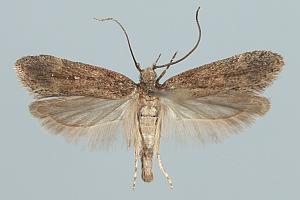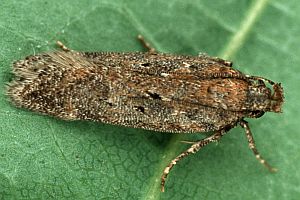1. Lebendfotos
1.1. Falter
2. Diagnose
2.1. Männchen
2.2. Weibchen
2.3. Genitalien
2.3.1. Männchen
2.3.2. Weibchen
2.4. Erstbeschreibung
3. Biologie
3.1. Habitat
4. Weitere Informationen
4.1. Etymologie (Namenserklärung)
Synonym Ancylis cerdanica: Nel, Varenne & Peslier (2020: 69) erläutern: „« cerdanica » pour rappeler la patrie d'origine de l'espèce, vraisemblablement une endémique pyrénéenne.“
4.2. Andere Kombinationen
- Gelechia distinctella Zeller, 1839 [Originalkombination]
4.3. Synonyme
- Chionodes praeclarella Herrich-Schäffer, 1854
- Gelechia striolatella Heinemann, 1870
- Gelechia tristella Teich, 1889
- Gelechia indistinctella Rebel, 1901
- Gelechia latiorella Amsel, 1939
- Chionodes deserticola Piskunov, 1979
- Chionodes cerdanica Peslier, Nel & Varenne, 2020 [synonymisiert durch Huemer & van Nieukerken (2021)]
4.4. Unterarten
- Gelechia distinctella unicolor Toll, 1947
4.5. Taxonomie
Nel, Varenne & Peslier (2020: 68) beschrieben ihre "Ancylis cerdanica" nach einem einzigen ♀, ohne eine DNA-Untersuchung durchzuführen. Hätte man mit der Veröffentlichung der Beschreibung noch gewartet, bis ein Barcoding-Ergebnis vorlag, wäre uns ein Synonym erspart geblieben. Jedenfalls fällt das Taxon genetisch voll und ganz in die Variationsbreite von C. distinctella und größere Abweichungen in Teilen des Genitals deuten hier eher auf einen (genetisch bedingten?) Genitaldefekt hin als auf eine eigenständige Art. Doch innerhalb C. distinctella scheint es tatsächlich 2 Cluster zu geben, die es Wert wären, genauer studiert zu werden. Huemer & van Nieukerken (2021: 323) erläutern zu C. cerdanica: "The holotype shows some unique features in genitalia, particularly the short and triangular antrum and the digitate distal part of the apophyses anteriores. However, the fully recovered DNA barcode despite not being barcode compliant, clearly indicates possible conspecifity with C. distinctella (Zeller, 1839). This species shows some genetic variation represented by a barcode cluster occurring in Finland and a widespread cluster in Europe with considerable genetic variation of 2.15% within this BIN (Huemer et al. 2020). The holotype of C. cerdanica nests in a geographically widespread cluster with only ca. 0.6% divergence from the nearest neighbour. Furthermore the female genitalia of both taxa are at least partially similar in the broad apophyses anteriores. Curiously, Nel et al. (2020) described the ductus and corpus bursae of C. cerdanica as transparent whereas they also stated that these structures were not found during preparation. Whereas the entrance of the ductus bursae is always visible at the anterior end of the antrum in Chionodes, it seems to be completely reduced in this specimen. Therefore we believe that the specimen is likely the result of a rare mutation or of a developmental anomaly that led to genitalia malformation." Sie sehen darin eine Parallele zum Fall "Mesapamea remmi".
(Autor: Erwin Rennwald)
4.6. Typenmaterial
Synonym Ancylis cerdanica: Nel et al. (2020: 68) erläutern: « HOLOTYPE femelle : France, Pyrénées-Orientales, Dorres (Ventajols), 1 600 m, 9 août 2019, S. Peslier leg., prép. gen. JN n° 33968, Coll. S. Peslier à Perpignan. »
4.7. Literatur
- Huemer, P. & E. van Nieukerken (2021): Identity of some recently described Lepidoptera from France — re-assessed with DNA barcodes and morphology. — Zootaxa 4941 (3): 301–337. [zum open-access-Artikel und PDF-download auf mapress.com]
- Beschreibung als Chionodes cerdanica: Nel, J., Varenne, T. & S. Peslier (2020): Descriptions de cinq nouveaux microlépidoptères : Isophrictis lineatella littorella ssp. n., Chionodes cerdanica sp. n., Ancylis paraobtusana sp. n., Epiblema bonifaciensis sp. n. et Dichrorampha mazeli sp. n. (Lepidoptera, Gelechiidae, Tortricidae). — Revue de l'Association Roussillonnaise d'Entomologie 29 (1): 66-74.
- [SCHÜTZE (1931): 14]
- Erstbeschreibung: Zeller, P. C. (1839): Versuch einer naturgemäßen Eintheilung der Schaben. — Isis von Oken 1839 (3): 167–220. Leipzig (Brockhaus).



![Vorkommen in Österreich [Huemer (2013: NR 1448)]](/res/img/flag/at.png)
![Vorkommen in Norwegen (außer Spitzbergen und Jan Mayen) [Aarvik & al. (2017): Nordic-Baltic Checklist]](/res/img/flag/no.gif)
![Vorkommen in Dänemark (außer Färöer-Inseln und Grönland) [Aarvik & al. (2017): Nordic-Baltic Checklist]](/res/img/flag/dk.gif)
![Vorkommen in Schweden [Aarvik & al. (2017): Nordic-Baltic Checklist]](/res/img/flag/se.gif)
![Vorkommen in Finnland (außer Åland-Inseln) [Aarvik & al. (2017): Nordic-Baltic Checklist]](/res/img/flag/fi.gif)
![Vorkommen in Russland (europäischer Teil bis Manytsch-Niederung) [Kozlov, Kullberg & Zverev (2014)]](/res/img/flag/ru.gif)
![Vorkommen in der Ukraine (ohne Halbinsel Krim) [Karolinskiy, Demyanenko, Bidzilya, Budashkin, Guglya, Kavurka, Mishinskiy & Zhakov (2019)]](/res/img/flag/ua.gif)
![Vorkommen auf der Krim [Sinev (2021)]](/res/img/flag/ua-kri.gif)
![Vorkommen in Weißrussland [Pisanenko, A., Švitra, G. & V. Piskunov (2019): Checklist of Lepidoptera recorded from Belarus]](/res/img/flag/by.gif)
![Vorkommen in Estland [Aarvik & al. (2017): Nordic-Baltic Checklist]](/res/img/flag/ee.gif)
![Vorkommen in Lettland [Aarvik & al. (2017): Nordic-Baltic Checklist]](/res/img/flag/lv.gif)
![Vorkommen in Litauen [Aarvik & al. (2017): Nordic-Baltic Checklist]](/res/img/flag/lt.gif)
![Vorkommen in Polen [Buszko J. & J. Nowacki [eds] (2017): A Distributional Checklist of the Lepidoptera of Poland]](/res/img/flag/pl.gif)
![Vorkommen in Tschechien [Laštůvka, Z. & J. Liška (2011): Komentovaný seznam motýlů České republiky]](/res/img/flag/cz.gif)

![Vorkommen in Ungarn [Pastorális et. al. (2018): A Magyarországon előforduló molylepke-fajok névjegyzéke]](/res/img/flag/hu.gif)
![Vorkommen in Großbritannien [Agassiz, Beavan & Heckford (2013): Checklist of the Lepidoptera of the British Isles]](/res/img/flag/gb.gif)
![Vorkommen in Irland einschließlich Nordirland [Bond & O'Connor (2012): Checklist of Irish Species]](/res/img/flag/ie.gif)
![Vorkommen in Belgien [De Prins(2016): Catalogus van de Belgische Lepidoptera]](/res/img/flag/be.gif)
![Vorkommen in den Niederlanden [Kuchlein & de Vos (1999): Annotated Checklist of the Dutch Lepidoptera]](/res/img/flag/nl.gif)
![Vorkommen in Luxemburg [Hellers (2018): Gelechiidae]](/res/img/flag/lu.gif)
![Vorkommen in Frankreich (europäisches Territorium ohne Korsika) [Vandromme et al. (2020): Liste systématique et taxinomique des Lépidoptères de France]](/res/img/flag/fr.gif)
![Vorkommen in Spanien (Festland) [Vives Moreno A. (2014)]](/res/img/flag/es.gif)
![Vorkommen in Portugal (Festland) [Corley (2015): Lepidoptera of Continental Portugal]](/res/img/flag/pt.gif)
![Vorkommen in Italien (Festland und kleine festlandsnahe Inseln) [Baldizzone et al. (1995): Checklist delle Specie della Fauna Italiana 83]](/res/img/flag/it.gif)
![Vorkommen auf Sardinien [Baldizzone et al. (1995): Checklist delle Specie della Fauna Italiana 83]](/res/img/flag/it-sar.png)
![Vorkommen in Sizilien [Baldizzone et al. (1995): Checklist delle Specie della Fauna Italiana 83]](/res/img/flag/it-sic.png)
![Vorkommen in Slowenien [Lesar & Govedič (2010): Check list of Slovenian Microlepidoptera]](/res/img/flag/si.gif)
![Vorkommen in Kroatien [Rebel (1904): Lepidopterenfauna der Balkanländer]](/res/img/flag/hr.gif)
![Vorkommen in Bosnien und Herzegowina [Rebel (1904): Lepidopterenfauna der Balkanländer]](/res/img/flag/ba.gif)
![Vorkommen in Serbien [Jakšić (2016): Tentative Checklist of Serbian microlepidoptera]](/res/img/flag/rs.gif)
![Vorkommen in Montenegro [Fotos Friedmar Graf in Lepiwiki]](/res/img/flag/me.gif)
![Vorkommen in Nordmazedonien [Huemer, Krpač, Plössl & Tarmann (2011)]](/res/img/flag/mk.gif)
![Vorkommen in Rumänien [Rákosy L. & M. Goia (2021): Lepidopterle din România: lista sistematică şi distribuţie]](/res/img/flag/ro.gif)
![Vorkommen in Bulgarien [Rebel H. (1903): Lepidopterenfauna der Balkanländer - Bulgarien und Ostrumelien]](/res/img/flag/bg.gif)
![Vorkommen in Griechenland (Festland und festlandsnahe Inseln) [Gozmany (2012): The Lepidoptera of Greece and Cyprus Volume I]](/res/img/flag/gr.png)
![Vorkommen im asiatischen Teil der Türkei [Koçak & Kemal (2018)]](/res/img/flag/tr.gif)
![Vorkommen in Iran [Rajaei & al. (2023)]](/res/img/flag/ir.gif)




























